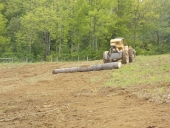




Bolar clay loam ph 7.4 lightened with mulch, sand and sulfur. Caliche limestone 4-12" under that, so we build up deeper with retaining walls.
Agorist, Texas Master Gardener, 0-3 zone permaculture = from slippers to cattle.
https://soilseries.sc.egov.usda.gov/OSD_Docs/B/BOLAR.html




Invasive plants are Earth's way of insisting we notice her medicines. Stephen Herrod Buhner
Everyone learns what works by learning what doesn't work. Stephen Herrod Buhner
 1
1








Jack Edmondson wrote:Reno,
A few questions for you:
What is your forage plan/goals? You say you want to supplement natives, but to what end other than nutrition? Is soil health part of the plan?
Are you going to rotationally graze, traditionally graze, take any hay/stockpile?
What equipment do you have other than the disk? Has germination with the disk, cast, drag program? Has germination been an issue with this method?
Why milo and are you interested in discussing alternatives?
Here are a few suggestions for cattle forage that might work well for you. Red River Crabgrass. An annual grass but good reseeder, so it comes back each year as long as you don't cut before seed formation. It only needs to be about 1/4 inch in depth to germinate. If you cast and drag, you should see good germination rates.
Chicory and plantain. Good deep root system. Perennial plants that will give a diverse pasture for years to come. Won't out compete grasses. 1/4-1/2 inche depth of seed, so goes well with other small seed grasses in a cast and drag process. I would also throw red and white clover into a 4 way blend of crab grass/chicory/plantain/clover and any native grass seed you can afford. (dang that stuff is pricey!)
If you are looking for warm season forage in Texas Sunn Hemp/Milo/Sorghum/velvet bean (hard to find those seeds.) disked down to about a 1/2 inch cast and drug will give you a lot of high protein that is fast growing and handles drought well. Sunflowers and a few other seeds rounds out diversity for the soil in a mix. Sunn Hemp will get to six feet in 90 days and can be grazed or cut all summer until first frost, same with velvet bean. Hemp and velvet bean are nitrogen fixers, so help with fertility as they grow.
This is my spring pasture plan if I can get enough mesquite cut to get a tractor into one of my pastures. If you need some resources for seed suppliers or more info on what the crops contribute, I would be happy to answer any questions.
 1
1









|
Warning! Way too comfortable! Do not sit! Try reading this tiny ad instead:
A PDC for cold climate homesteaders
http://permaculture-design-course.com
|



